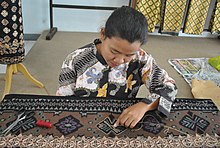Tapis (Indonesian weaving style)
 Tapis being sold at the store in Indonesia | |
| Type | Art Fabric |
|---|---|
| Material | silk, cotton, gold, silver |
| Place of origin | Lampung, Indonesia[1][2][3][4] |
| Part of a series on |
| Islamic culture |
|---|
| Architecture |
| Art |
|
| Clothing |
| Holidays |
|
| Literature |
| Music |
|
| Theatre |
|
Tapis (Rejang: ꤳꤶꥇꤼ꥓; Indonesian: kain tapis or simply tapis) is a traditional weaving style and also refers to resulting cloth that originated from Lampung, South Sumatra, Indonesia.[5][6][7][8] It consists of a striped, naturally-coloured cloth embroidered with warped and couched gold thread. Traditionally using floral motifs, it has numerous variations. It is generally worn ceremonially, although it can be used as a decoration. It is considered one of the symbols of Lampung and Lampungese.[9]
Etymology[]

The word tapis is derived from the Old Javanese (Kawi) word of "tapih" (ꦠꦥꦶꦃ), which means "the long cloth or fabric to cover".[10]
Production[]

Tapis is generally made by Lampungese women. It consists of a woven, naturally coloured fabric with warped gold and silk embroidery.[11][12] The gold thread, shaped in stripes, chevrons, and checks, contrasts the colours of the fabric.[11][12] Tapis can also be decorated with beads, mica chips, or old colonial coins.[11][13][14]
The gold embroidery is affixed using couching techniques, minimalizing waste.[15] The gold thread is attached in sections, then couched with a different, less expensive, thread at turns. This ensures that none of the gold thread is used in a non-visible area.[15][16]
Traditionally, tapis has floral motifs. However, modern tapis may also be based on the weaver's own design and include non-floral motifs, such as Arabic calligraphy.[14] Other designs may include snakes, ships, and mythical creatures.[12] Some tapis, called tapis tua (old tapis), are covered entirely in golden embroidery.[17]
Although generally produced by Lampungese home industries, tapis is also produced in other areas, including Kendal, Central Java[11] and Pisang Island.[18]
Use[]

Traditionally, tapis is worn as a sarong for weddings, Eid ul-Fitr celebrations, and welcoming ceremonies. However, tapis can also be used as a wall decoration.[14] When worn, it forms a cylinder around the wearer's legs.[19]
Reception[]
Tapis has come to be seen as a symbol of Lampung.[11] Some people describes tapis as having "exceptional beauty and sophistication",[20] while some describes viewing tapis as "like seeing countless possibilities in art and life portrayed in cloth".[16]
The price of tapis reflects its age. Generally, the older a tapis the more it costs. Antique tapis are also collectors items, collected by both Indonesians and foreigners.[11]
Gallery[]

Tapis of Kauer people, Lampung at the Textile Museum of Canada

Tapis from Lampung c. 18th century (or earlier) at the collection of Metropolitan Museum of Art, New York

A black and red tapis
See also[]
References[]
- Footnotes
- ^ Totton, Mary Louise (2009). Wearing Wealth and Styling Identity: Tapis from Lampung, South Sumatra, Indonesia. Hanover, New Hampshire, United States of America: Hood Museum of Art, Dartmouth College. ISBN 978-0944722374.
- ^ Mary, Louise Totton (1994). "A Red Ikat Tapis: Ships and the Lands Beyond". Bulletin of the Detroit Institute of Arts. 68 (3). Retrieved 15 March 2021.
- ^ Richter, Anne (1994). "Arts and crafts of Indonesia". Chronicle Books Llc.
- ^ Wardwell, Anne E (1985). "Tapis: A Rare Sarong from South Sumatra". The Bulletin of the Cleveland Museum of Art. 72 (5).
- ^ Totton, Mary Louise (2009). Wearing Wealth and Styling Identity: Tapis from Lampung, South Sumatra, Indonesia. Hanover, New Hampshire, United States of America: Hood Museum of Art, Dartmouth College. ISBN 978-0944722374.
- ^ Mary, Louise Totton (1994). "A Red Ikat Tapis: Ships and the Lands Beyond". Bulletin of the Detroit Institute of Arts. 68 (3). Retrieved 15 March 2021.
- ^ Richter, Anne (1994). "Arts and crafts of Indonesia". Chronicle Books Llc.
- ^ Wardwell, Anne E (1985). "Tapis: A Rare Sarong from South Sumatra". The Bulletin of the Cleveland Museum of Art. 72 (5).
- ^ Subagio, Puji Yosep (1999). "North Coast Java Batik" (PDF). Tokyo University. Retrieved 15 March 2021.
- ^ Budiman, Hary Ganjar (2013). "Makna dan Nilai Budaya Tapis Inuh pada Masyarakat Pesisir di Lampung Selatan" [The Meaning and Cultural Values of Tapis Inuh in South Lampung Coastal Communities]. Patanjala (in Indonesian). 5 (3). doi:10.30959/patanjala.v5i3.116. Retrieved 4 March 2021.
- ^ Jump up to: a b c d e f Oyos Saroso (22 January 2007). "Rusiana Makki, empowering women through 'tapis'". The Jakarta Post. Retrieved 6 August 2011.
- ^ Jump up to: a b c Maxwell 2003, pp. 112–113
- ^ Rodgers, Summerfield & Summerfield 2007, p. 36
- ^ Jump up to: a b c Nia S. Kim (10 June 2001). "Lampung offers a whole lot more besides jungle adventures". The Jakarta Post. Retrieved 6 August 2011.
- ^ Jump up to: a b Maxwell 2003, p. 316
- ^ Jump up to: a b Forshee 2006, p. 144
- ^ (Maxwell 2003, p. 184)
- ^ Backshall 2003, p. 502
- ^ Maxwell 2003, p. 319
- ^ Stevie Emilia (10 April 2011). "Journeying through textile traditions". The Jakarta Post. Retrieved 6 August 2011.
- Bibliography
- Backshall, Stephen (2003). The Rough Guide to Indonesia. Rough Guides. p. 565. ISBN 1-85828-991-2. Retrieved 20 December 2010.
- Forshee, Jill (2006). Culture and Customs of Indonesia. Westport, Connecticut: Greenwood Press. ISBN 978-0-313-33339-2.
- Maxwell, Robyn J. (2003). Textiles of Southeast Asia : Tradition, Trade, and Transformation. Hong Kong: Periplus. ISBN 978-0-7946-0104-1.
- Rodgers, Susan; Summerfield, Anne; Summerfield, John (2007). Gold Cloths of Sumatra : Indonesia's Songkets from Ceremony to Commodity. Leiden: KITLV Press. ISBN 978-90-6718-312-3.
| Wikimedia Commons has media related to Tapis (Indonesian textile). |
- Indonesian clothing
- Textile industry of Indonesia



